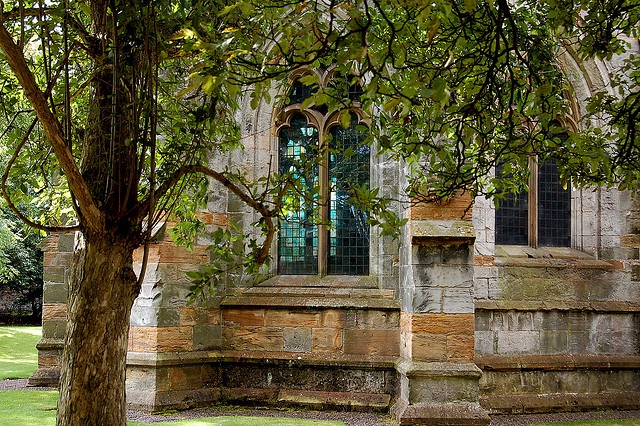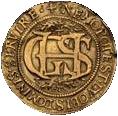|
The Official History of the
Seton Family
Seton, Seeton, Seytoun,
or Seaton: a
topographical name; meaning "sea town",
which came to be attached to the
shipping magnates who mastered the medieval North Sea.
 The word has several variant
spellings the last form being the oldest. It derived not from
Scotland but from the north-east coast of England, notably Durham
where there are five places so called: In Northumberland where
there are eight, Yorkshire has two named Seatons and a third –
actually the most important of them all – which has nowadays lost
that designation. The small harbour village of Staithes, nine
miles north of Whitby, was in the 11th century called Seaton
Staithes. It was an important place, private if not secret to its
users, hidden in a cleft in the cliffs and extremely difficult of
access. As the old name indicates, it was a stronghold for the
Seatons. Seaton Quay is
at the safest point in the harbour, and Seaton Hall has stood for many centuries
at the top of the cliff directly above it. The word has several variant
spellings the last form being the oldest. It derived not from
Scotland but from the north-east coast of England, notably Durham
where there are five places so called: In Northumberland where
there are eight, Yorkshire has two named Seatons and a third –
actually the most important of them all – which has nowadays lost
that designation. The small harbour village of Staithes, nine
miles north of Whitby, was in the 11th century called Seaton
Staithes. It was an important place, private if not secret to its
users, hidden in a cleft in the cliffs and extremely difficult of
access. As the old name indicates, it was a stronghold for the
Seatons. Seaton Quay is
at the safest point in the harbour, and Seaton Hall has stood for many centuries
at the top of the cliff directly above it.
After Domesday but before the end of the 11th century the family name had been drawn
inland, most portentously to Rutland, where at the new manor of Seaton the Lady
Maud de Lens and her sister Alice were spending the betrothal period before
their marriages. Maud’s Scottish son, Prince Henry, would pass the name to
Seaton, Cumbria, where he established a cell of his abbey at Holmcultram.
Earlier than either of these moves, it went to the Firth of Forth where Queen
Maud’s premier Flemish relative, her uncle Seier "de Seton" built
his great palace for the protection of herself and her heirs.
Like
so many other pedigrees, the Norman origin offered for the Seton family is
careless nonsense. The name was said to be made up from "the town of the
Say". William de Say, son of the Conqueror’s companion of the same name,
married a sister of Geoffrey de Mandeville, Earl of Essex, and took the
Mandeville arms of quartered gold and red. There is no possible connection with
the Setons - except that William de Say was lord of Hamme, in West Flanders,
probably through his Flemish wife, and his arms were in the tinctures of
Boulogne.
As
their own distinctive crescents show, Seier de Seton and his brother Walter
sprang from a second son of the house of Boulogne. Known in their Flemish
homeland as Seier and Walter de Lens, they were sons of Count Eustace’s second
son, Count Lambert de Lens, whose daughter by a second marriage (to the sister
of William the Conqueror) was the Countess Judith, mother of Scotland’s Queen
Maud. Seier’s eldest son, Walter de Lens, or Walter the Fleming as he is
described in Domesday, had his chief English home at Wahull (now called Odell)
in Bedfordshire. On the Firth of Forth, as heir there of his father, Seier, he
was called Dougall or "the dark stranger", a nickname which was also
given to his own son Walter, and duly recorded by the family’s first official
chronicler, Sir Richard Maitland of Lethington, in 1554.
Of Flemish and of
Carolingian lineage, the manuscript at the British
Museum from the 16th century it states that "their
surnam came home with King Malcolme Camoir foorth of
Ingland". Chalmers in his "Caledonia" states that the
first Setons were members of a Norman (Flemish)
family named "Say" (which was incorrect), and that they
obtained from David I land in East Lothian which were
called Sey-tun. Sir Richard Maitland of Lethington wrote
a "Historie or Chronicle of the Hous and Surename of
Seytoun" down to the year 1559, wrote that King Malcolm
Canmore "gaif to the predecessour and forebear of my
Lord Seytoun the surename of Seytoun... appearandlie be
ressoun that the gentilman... possessit the landis of
Seytoun for the tyme... thay landis ar callit Seytoun
for ane grit caus, becaus thay ly hard upon the Sey cost
and the Toun thairof is neir to the Sey."
In both Scotland and Bedfordshire, and no doubt in the lost
Yorkshire home of the family, Seier de Lens (or Seier de Seton)
and his descendants kept as princely an establishment as they had
enjoyed in Flanders – a fact attested by a curious documentary
survival. As if he had been a king, Walter de Wahull had
tenants-in-chief, each with his own tenants. The terms these
courtiers enjoyed on his estates at Odell are known, and although
the relevant Scottish documents have not survived, it is certain
that the Seton tenants on the Firth of Forth had been given
similar privileges. The Victoria County History for Bedfordshire
records, not without astonishment, the fairy-tale rents paid by
Walter’s knightly tenants in that county as "a rose, an arrow, a
handful of rushes, capons, wax, a pair of gloves …" Lesser tenants
paid more; the cottager William Prikeavant provided a hooded
falcon, while Walter le Sergeaunt, keeper of the park at Odell
Castle, held his cottage by the service of twelve arrows. At the
neighbouring Little Odell Manor, whose Domesday tenant-in-chief
was Walter’s great-uncle, Count Eustace II of Boulogne, the
tenancies granted to Eustace’s own attendant knights were similar,
"a garland of roses, a bundle of rushes, a cake of wax …"
One Scottish tenancy tradition which has survived concerns the
Tower at Tranent, which was held of the crown first by de Quincy
and then by Seton; it had for payment that most magical of
rentals, a rose in midwinter, a snowball in midsummer. The trust
implicit in these terms of tenancy was of the same kind as that
loyalty which would bind Seton to Scotland, to their cousin Maud
and her descendants so long as they sat on the Scottish throne. It
was a loyalty which would last unbroken to the disasters of the
Fifteen and the Forty-five.
Beryl Platts ("Scottish Hazard" vol 1,
The Procter Press, 1985)
Of the Seton family The Great Historic Families Of Scotland says:
‘The Setons are
among the most illustrious of the great houses of Scotland,
conspicuous throughout their whole history for their loyalty and
firm attachment to the Stewart dynasty, in whose cause they
perilled and lost their titles and extensive estates.’ The
family’s founder, Seier de Seton (or de Lens), had been granted
lands in East Lothian to which he gave his own name. His son,
Walter de Seton (also called Dougall), married Janet de Quincy,
hieress of that once powerful family, and gained the lands of
Tranent bordering his own. He also acquired the lands of
Wynchburgh, West Lothian. The family continued to marry into
powerful alliances and later Sir Christopher Seton (Sir Chrystell)
married Christian Bruce, sister of Robert I (the Bruce). After his
legendary support of his brother-in-law he was captured by the
English, taken to London, then executed at Dumfries. One of his
brothers, Sir John Seton, shared the same fate. Alexander Seton,
Sir Christopher's son, survived the wars of independence to be a
signatory of the Arbroath Declaration. He also was a recipient of
King Robert’s gratitude towards the family: the existing Seton
lands were enlarged by means of adding those confiscated from
anglo-supporters, and a large stretch of East Lothian coastline
became Seton territory.
The family
continued to play a distinguished and colourful part in the
developing history of Scotland, marrying into other noble
Scots-Flemish families and from time to time into the fringes of
royalty. One interesting member of the main line was the fourth
Lord Seton, who was one of James IV’s Renaissance men par
excellence. Towards the end of the fifteenth century he endowed a
collegiate church in the small town that bears his name with
support for a provost, six prebendaries, two choir boys and a
clerk. He was an early scientist and is described as ‘meikle given
to leichery [medicine, not lustfulness], and as cunning in divers
science as in music, theology, and astronomy’. In addition to his
talent for learning he had a tremendous taste for extravagance,
building houses as well as his church. As well, he spent vast sums
of money on buying a great ship called the Eagle, for the sole
purpose of conducting a personal vendetta against some Danish
privateers who had plundered him on one of his many visits to
France.
George, sixth
Lord Seton, was twice married. His second wife, Marie Pyeris
(pronounced Pee-yair-ee), was one of the ladies-in-waiting who had
accompanied Marie de Guise from France on her marriage to King
James V. The family of Guise, influential in France, was also a
descendant of those once prominent Flemish-Boulognaise. His
daughter by this second marriage was the famed Mary Seton, one of
the four Mary’s of Mary Stuart, Queen of Scots. He was succeeded
by his son, George, who was to play a distinguished part in the
Queen’s affairs.
George,
seventh Lord Seton, was one of the commisioners appointed to
attend the young Mary Stuart’s marriage to the Dauphin of France
in 1557. He remained faithful to the old Catholic religion, but
not without interest in the reformation; as a young man he had
been following the progress of the new religion and even attended
a sermon by John Willock, from the preachers deathbed. However his
remaining within the Church of Rome kept him inside the close
party of the Queen. In 1559 he held the office of Provost of
Edinburgh, and after the Queen’s return from France, he was
appointed Grand Master of the Royal Household. It was at the home
of the Seton family that Queen Mary spent some of the crucial
moments of her short and troubled reign.
The
seventh Lord was to the fore in most of the events during Mary
Stuart’s reign: in March 1566 she rode to Seton after the murder
of her Italian secretary, David Riccio (Rizzio); the following
year again she was at Seton after the murder of her 2nd husband
Henry Stuart, Lord Darnley (they having spent their honeymoon at
Seton); and he was instrumental in arranging her escape from
captivity at Lochleven Castle in 1568, where he waited on the
shore and escorted the Queen to safety at his nearby castle of
Niddry with two hundred mounted lances. Following the defeat of
the Queen’s forces at the battle of Langside, his titles and
estates forfeit, he went into exile in Flanders. He returned
sometime after her imprisonment (having come close to being
imprisoned himself for trying to bring aid from Flanders) and was
restored by James VI, spending the remainder of his days as
ambassador to France.
The
Seton family was again at the cause of the Stuarts, playing a part
in the rescue of Queen Mary’s son, the then young James VI, from
captivity at the hands of the Douglas family. They were also
instrumental in the negotiations for James VI’s ascendency to the
English throne. The Eighth Lord Seton was duly created First Earl
of Winton by King James VI in 1600, and his brother Alexander rose
to be Chancellor of Scotland and Earl of Dunfermline. The family
also supported Kings Charles I and Charles II and James VII and
II. As fervent supporters of the Stuart dynasty, it is no surprise
that they took to the Jacobite causes, and were attainted and
forfeit of their lands and titles. It was to this end that they
climaxed their extraordinary history.
The Seton family’s chief residence was at the splendid Palace of
Seton. It had stood on the lands named after the family since
before the time David I. The lands of Seton took their name from
the estates which were formally held in England; principally
Seaton-Staithes,
Yorkshire. The old Palace of Seton had endured much destruction
and rebuilding over the centuries, being much destroyed because of
its proximity on the main invasion route from England. It had
however kept its original layout and French styling throughout its
existence. The original plan was based around a triangular
(actually a quadrangle) courtyard, described late in the
seventeeth century as follows:
 ‘The house
consisted of two large fronts of freestone, and in the middle is a
triangular court. The front to the south east hath a very noble
apartment of a Hall, a Drawing Room, a handsome Parlour,
Bedchamber, Dressing Room and closet. This apartment seems to have
been built in the reign of Mary Queen of Scots; for on the ceiling
of the Great Hall are plastered the Arms of Scotland, with the
Arms of France on one hand…the front to the North seems to be a
much older building than this. The apartments of the state are on
the second story, and very spacious; three great rooms, at least
forty feet high, which they say were finely furnished, ever since
Mary Queen of Scots, on her return from France, kept her
apartments there.’ ‘The house
consisted of two large fronts of freestone, and in the middle is a
triangular court. The front to the south east hath a very noble
apartment of a Hall, a Drawing Room, a handsome Parlour,
Bedchamber, Dressing Room and closet. This apartment seems to have
been built in the reign of Mary Queen of Scots; for on the ceiling
of the Great Hall are plastered the Arms of Scotland, with the
Arms of France on one hand…the front to the North seems to be a
much older building than this. The apartments of the state are on
the second story, and very spacious; three great rooms, at least
forty feet high, which they say were finely furnished, ever since
Mary Queen of Scots, on her return from France, kept her
apartments there.’
The current
Seton House, constructed 1790 by Alexander MacKenzie, has nothing
in common with its predessesor, having not been constructed by a
member of the family, nor designed by a relative. The sole
remaining fragments of the Palace being only the barrel-vaulted
ground floor and pieces of the foundation.
Kenneth Seton, 1993.
|


